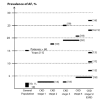Atrial Fibrillation and Oral Anticoagulation in Chronic Kidney Disease
- PMID: 28496732
- PMCID: PMC5153198
- DOI: 10.4022/jafib.445
Atrial Fibrillation and Oral Anticoagulation in Chronic Kidney Disease
Abstract
Due to several unfavorable epidemiological changes, chronic kidney disease (CKD) and treatment of its associated cardiovascular morbidity have become a worldwide problem. Thus, atrial fibrillation (AF) is the most common arrhythmia and frequently associated with renal impairment: prevalence for AF is up to 27% in long-term hemodialysis patients and in general more than 25% in all CKD patients 70 years and older. Thromboembolism and stroke are the major complications of AF. Two-year death rates for CKD patients after stroke range between 55% and 74%. Although treatment of AF in the general population is well defined, patients with CKD and AF are often undertreated due to lack of studies and guidelines. In this review recent data concerning incidence and prevalence of AF, stroke, and major bleedings in CKD patients are presented. Particular attention is paid to the available data about the different types of oral anticoagulation therapy with regard to CKD stage, including the new oral anticoagulant drugs dabigatran, rivaroxaban, and apixaban. Stratification algorithms for stroke risk in general, and individualized risk stratification for oral anticoagulation in CKD patients are discussed in detail.
Figures

Similar articles
-
Oral Anticoagulants to Prevent Stroke in Nonvalvular Atrial Fibrillation in Patients With CKD Stage 5D: An NKF-KDOQI Controversies Report.Am J Kidney Dis. 2017 Dec;70(6):859-868. doi: 10.1053/j.ajkd.2017.08.003. Epub 2017 Sep 21. Am J Kidney Dis. 2017. PMID: 28941763
-
[The Choice of Anticoagulant Therapy in Patients With Non-Valvular Atrial Fibrillation and Chronic Kidney Disease].Kardiologiia. 2017 Jan;(1):76-85. Kardiologiia. 2017. PMID: 28290837 Clinical Trial. Russian.
-
Non-vitamin K antagonist oral anticoagulation agents in anticoagulant naïve atrial fibrillation patients: Danish nationwide descriptive data 2011-2013.Europace. 2015 Feb;17(2):187-93. doi: 10.1093/europace/euu225. Epub 2014 Sep 18. Europace. 2015. PMID: 25236181
-
Nonvitamin K-dependent oral anticoagulants (NOACs) in chronic kidney disease patients with atrial fibrillation.Thromb Res. 2017 Jul;155:38-47. doi: 10.1016/j.thromres.2017.04.027. Epub 2017 May 4. Thromb Res. 2017. PMID: 28482261 Review.
-
Non-Vitamin K-Dependent Oral Anticoagulants for Nonvalvular Atrial Fibrillation in Patients With CKD: Pragmatic Considerations for the Clinician.Am J Kidney Dis. 2018 Nov;72(5):717-727. doi: 10.1053/j.ajkd.2018.02.360. Epub 2018 May 2. Am J Kidney Dis. 2018. PMID: 29728318 Review.
Cited by
-
Design and rationale of a randomised controlled trial comparing apixaban to phenprocoumon in patients with atrial fibrillation on chronic haemodialysis: the AXADIA-AFNET 8 study.BMJ Open. 2018 Sep 10;8(9):e022690. doi: 10.1136/bmjopen-2018-022690. BMJ Open. 2018. PMID: 30206088 Free PMC article.
References
-
- K/DOQI clinical practice guidelines for chronic kidney disease: evaluation, classification, and stratification. Am. J. Kidney Dis. 2002 Feb;39 (2 Suppl 1):S1–266. - PubMed
-
- U S Renal Data System, USRDS 2010 Annual Data Report: Atlas of Chronic Kidney Disease and End-Stage Renal Disease in the United States. National Institutes of Health, National Institute of Diabetes and Digestive and Kidney Diseases, Bethesda, MD. 2010;0:0–0.
-
- Meguid El Nahas A, Bello Aminu K. Chronic kidney disease: the global challenge. Lancet. 2005 Jan 25;365 (9456):331–40. - PubMed
-
- Reinecke Holger, Trey Torsten, Matzkies Fritz, Fobker Manfred, Breithardt Günter, Schaefer Roland M. Grade of chronic renal failure, and acute and long-term outcome after percutaneous coronary interventions. Kidney Int. 2003 Feb;63 (2):696–701. - PubMed
Publication types
LinkOut - more resources
Full Text Sources
